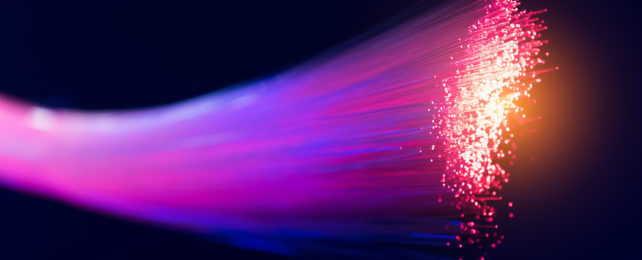Scientists continue to blow through data transmission records, with the fastest transmission of information between a laser and a single optical chip system now set at 1.8 petabits per second. That's well in excess of the amount of traffic passing across the entire internet each second.
Here's another comparison: the average broadband download speed in the US is 167 megabits per second. You need 1,000 megabits to get to a gigabit, and then 1 million gigabits to get up to 1 petabit.
No matter how you present it, 1.8 petabits is a serious amount of data to transmit in a second.
The supercharged data transfer system is built around a custom-design optical chip, which uses the light from a single infrared laser and splits it into hundreds of frequencies. The frequencies are isolated at fixed distances from each other, like teeth in a comb – hence the name for this setup, which is a frequency comb.
Each 'tooth' on a frequency comb can send its own burst of data, which is how the huge transmission rates are achieved. Using more conventional means, around a thousand lasers would be needed to carry the same number of 1s and 0s.
"What is special about this chip is that it produces a frequency comb with ideal characteristics for fiber-optical communications," says nanoscientist Victor Torres Company from Chalmers University of Technology in Sweden.
"It has high optical power and covers a broad bandwidth within the spectral region that is interesting for advanced optical communications."
To achieve the feat, the researchers split the fiber-optic cable into 37 distinct core sections, and then each section was split into 223 different frequency slices – the teeth on the comb. Having so much data sent in parallel was crucial to achieving the record rate.
The actual data itself was encoded into the light signals using a process called modulation, which adjusts the height, strength, rhythm, and directions of light waves to store the 1s and 0s making up digital data.
For now this is just a proof of concept, not least because computers aren't capable of generating or receiving so much data at once. In the case of this piece of research, artificial 'dummy' data was used to make sure the system worked as intended.
What's more, extra components – including data encoding devices – need to be incorporated into the chip. Once this is done though, the researchers say, the resulting system will be much faster and less of a power draw than what we have currently.
"Our solution provides a potential for replacing hundreds of thousands of the lasers located at Internet hubs and data centers, all of which guzzle power and generate heat," says electrical engineer Leif Katsuo Oxenløwe from the Technical University of Denmark.
"We have an opportunity to contribute to achieving an Internet that leaves a smaller climate footprint."
Through the use of a computational model, the researchers were also able to determine that there's substantial potential when it comes to scaling up the system – even higher data transmission rates should be possible in the future.
By further splitting the light frequencies and further amplifying the signals produced, rates of up to 100 petabits per second are feasible, the models show. All this can be done without losing the reliability of the data.
Getting up to that stage is going to depend on improvements in other areas of computing, and in internet infrastructure, but the underlying technologies – lasers, optical fiber – aren't too far away from what we're already using.
"The more components we can integrate in the chip, the more efficient the whole transmitter will be," says Katsuo Oxenløwe. "It will be an extremely efficient optical transmitter of data signals."
The research has been published in Nature Photonics.
